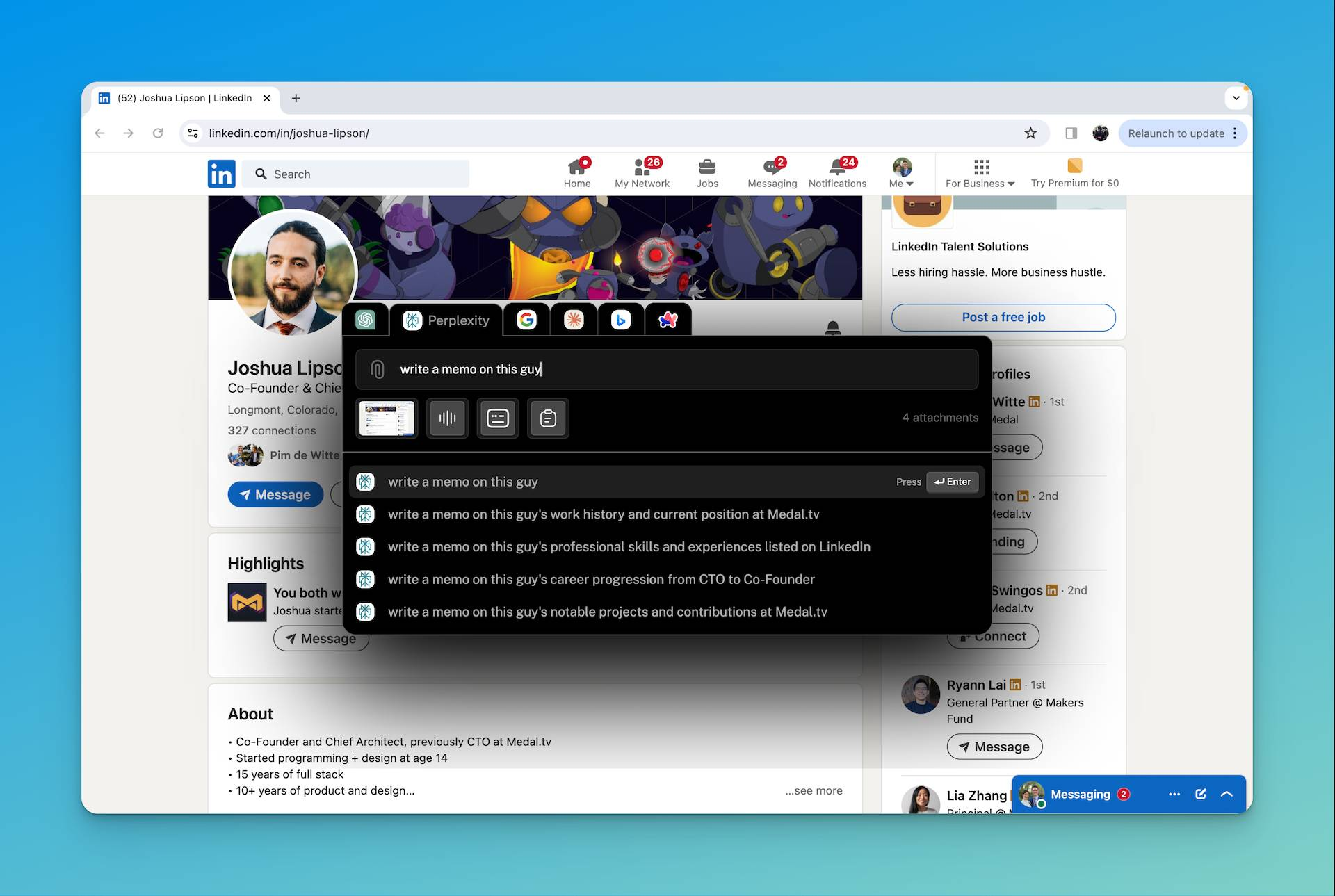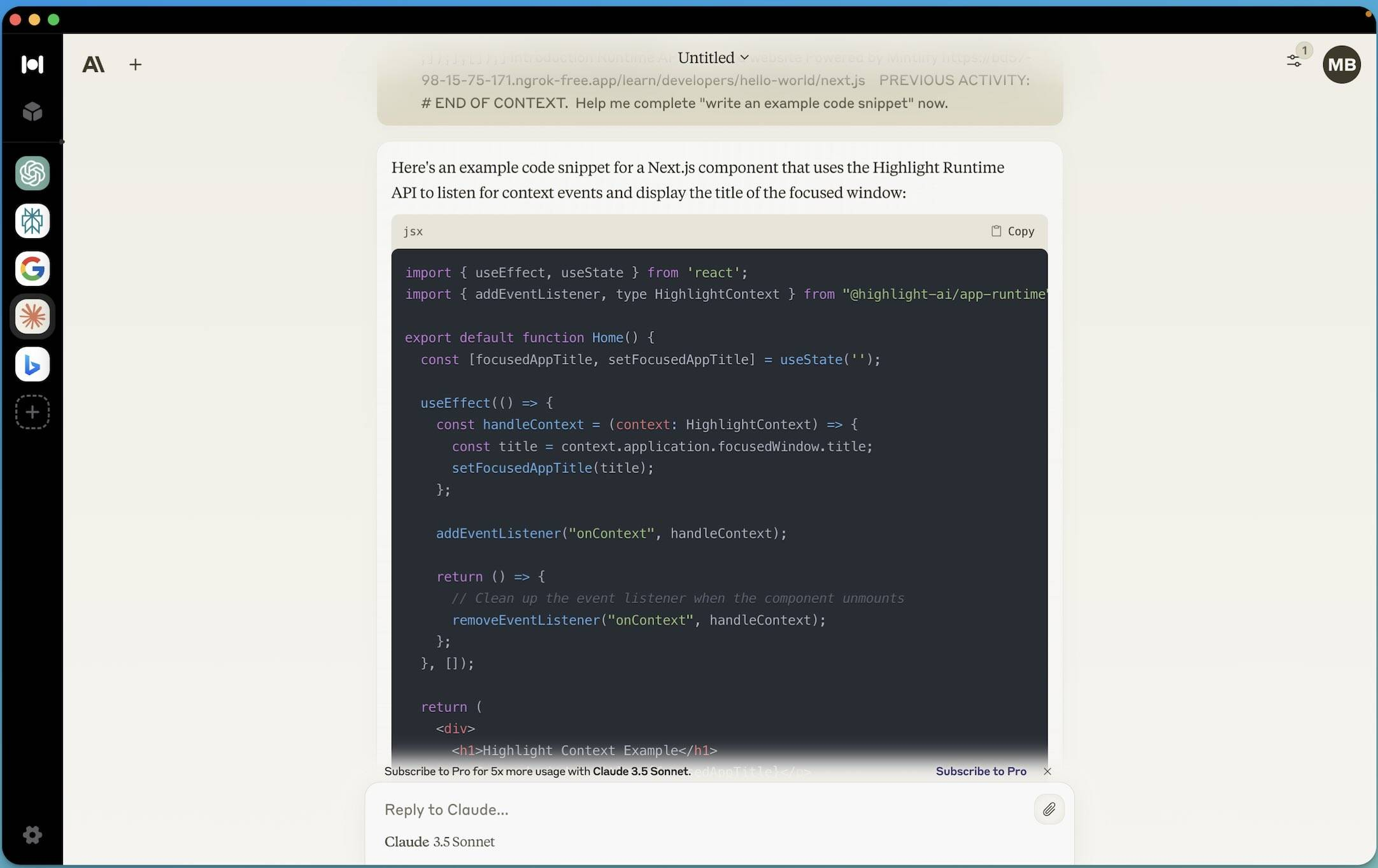包阅导读总结
1.
关键词:AI、Highlight、Medal、开发者、界面平台
2.
总结:Medal 的 CEO Pim de Witte 称非浏览器的 AI 界面平台 Highlight 为开发者提供新途径,它不仅是用户友好的界面,也是开发者平台,还为开发者提供资助,用户基础增长迅速。
3.
主要内容:
– Medal 是一个屏幕捕捉平台,拥有众多活跃用户。
– 利用其技术创建了名为 Highlight 的产品,可与多种 AI 交互。
– Highlight 特点
– 被视为桌面 AI 接口,而非浏览器中的。
– 能优化自然语言为提示,结合用户电脑应用信息。
– Highlight 作为开发平台
– 允许开发者用简单网络技术为桌面构建 AI 应用。
– 适用于 Windows 和 Mac,将支持 Linux。
– 有应用商店,提供用户上下文和 API。
– 开发者资助
– 提供高达 3 万美元的现场资助和 1 万美元的远程资助。
– 容易上手,添加代码和上下文即可。
思维导图:
文章地址:https://thenewstack.io/non-browser-ui-platform-for-ai-offers-grants-to-developers/
文章来源:thenewstack.io
作者:Loraine Lawson
发布时间:2024/7/24 17:56
语言:英文
总字数:1002字
预计阅读时间:5分钟
评分:87分
标签:人工智能界面,开发者补助,桌面应用,Medal,Highlight
以下为原文内容
本内容来源于用户推荐转载,旨在分享知识与观点,如有侵权请联系删除 联系邮箱 media@ilingban.com
Pim de Witte, software engineer and CEO of Medal, has a message for developers who want to use AI in their apps.
“If you’re an AI app, you’ve got to get out of the browser,” de Witte told The New Stack. “The point is that there needs to be this private intermediary that is not the browser, because the browsers are owned by the major companies… .”
De Witte heads the screen capture platform Medal, which allows gamers to record, clip, edit and share their gaming. The company currently has 1.3 million daily active users and 4 million monthly active users, he said. Medal leveraged its scraping technology — it scrapes but does not retain the information — to create a new way to interface with AI via a product it calls Highlight.
Highlight: A Different AI Interface
Internally, Medal refers to Highlight as a prompt engine, because it will take natural language and optimize it for a prompt, which is then sent to the AI of your choice. Highlight currently can leverage OpenAI’s GPT, Perplexity and Anthropic’s Claude, as well as Google Search.
It might help to think of it as an interface for AI that sits on your desktop, rather than in the browser. TechCrunch called it a “contextual AI assistant,” which is helpful but incomplete. It awaits instructions such as “Summarize this article” or even “Create a meme that represents this discussion.” Then it generates a prompt along with a screen capture and sends it all to one of the large language models. It provides the AI’s answer within its own interface without bringing you to the browser.
“We say we’re actually an interface company,” de Witte explained. “We are developing some of our own models, but fundamentally, we think this is an interface problem. This is not necessarily an AI problem. What we’ve done is we’ve removed the need for people to understand how to prompt.”
But it’s doing more than just launching an API query to those sites. It can also combine what it “knows” about you from your computer applications with those results.
For instance, when demoing Highlight, de Witte showed how it draws from its memory that he works at Medal and that the company prides itself on fostering a supportive, innovative culture, he explained. This allows it to do things that can’t be done within a browser environment, he added.
“Basically, it completely switches the way you interact with technology, because it already packages what it needs to know about you to provide the answers,” he said. “I can say pitch Ken to work at my company. It takes all of [those] native concepts from the browser in a way that a Chrome extension could never do. It then pairs that with what Highlight knows about me as a person.”
“…fundamentally, we think this is an interface problem. This is not necessarily an AI problem. What we’ve done is we’ve removed the need for people to understand how to prompt.”
– Pim de Witte, CEO of Medal
It sounds great for users — and it is. I tested Highlight for a week and soon found myself clicking on the Highlight icon — which hovers over any apps you’re in for easy access — more and more. In fact, it’s user base is growing an average of 15-20% each day, according to de Witte. It now has about 6,000 daily active users.

The Highlight interface. Image provided by Medal.
But what about developers? What’s the value add for web developers?
Highlight as a Development Platform
Highlight isn’t just a UI for pinging large language models. It’s a developer platform that allows developers to build AI apps for the desktop using simple web technologies, de Witte explained. Currently, it’s available for Windows and Mac, with the company working to add support for Linux soon. There’s a demo with code available on GitHub if you’re curious about what this looks like.
Medal is also building out an application store so that web developers can build their apps to run through Highlight’s interface. It provides access to the user’s context (what they’re doing on their machine) along with a set of APIs that allow developers to interact at an OS level, he said.
There are various note applications and chat assistant interfaces available on the app store, as well as a few surprising offerings, de Witte shared. For instance, one study app allows you to generate flashcards from material you’re reading on screen. There’s also an app that generates memes based on what’s currently on your screen, he said.
“You can just be looking at something and it will pull up the perfect meme for the situation without you having to go describe it,” he said.
Developer Grants Available
To build out its application store, Highlight is offering developers grants to create apps. If the developer is willing to work out of the Medal office to “really ramp up your company,” there is a $30,000 grant available, de Witte said. He added that Medal does not take equity from your company.
There are also remote grants available of up to $10,000, with half delivered when you start developing and the remainder if Highlight approves the app.
It’s easy to get up and running, he said: All the Highlight platform requires to work with a web application is a bit of code added to the npm package and your context, he said. There’s even instructions for how to create a Hello World app with Next.js.

A Highlight code sample with Next.js.
“You can run your exact browser interfaces that you would run inside your normal browser, and then you just have additional events,” de Witte said. “You just add the npm package. You say, Hey, here’s the context, and then it gives you access to stuff that browsers just won’t give you access to.”
YOUTUBE.COM/THENEWSTACK
Tech moves fast, don’t miss an episode. Subscribe to our YouTubechannel to stream all our podcasts, interviews, demos, and more.
